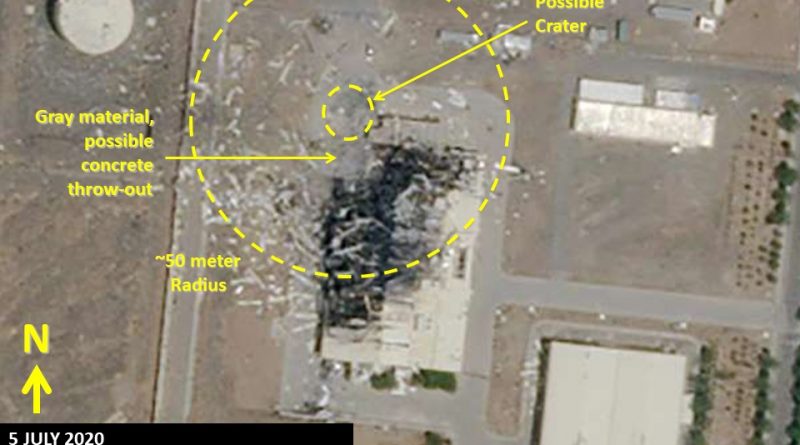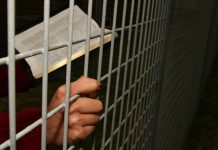Damage to Natanz centrifuge production may be irreparable/DebkaFile/July 11/2020
موقع دبيكا الإسرائيلي: الأضرار التي اصابت المفاعل النووي الإيراني “نطنز” هي كبيرة وقد تكون خارج نطاق التصليح
غموض حول تفجير ثالث في إيران… وإسرائيل تطلب طائرات من أميركا
لندن – تل أبيب: «الشرق الأوسط»/11 تموز/2020
طهران تتمسك بالرد إذا تأكد هجوم خارجي في «نطنز»
لندن – طهران: «الشرق الأوسط»/تقرير نشر في 08 تموز/2020
Damage to Natanz centrifuge production may be irreparable
موقع دبيكا الإسرائيلي: الأضرار التي اصابت المفاعل النووي الإيراني نطتز هي كبيرة وخارج نطاق التصليح
DebkaFile/July 11/2020
Iran is caught in a dilemma between hiding the true scale of damage caused to its nuclear program by the Natanz explosion and fire and the urge to punish the culprit. On July 10, Foreign Ministry spokesman Abbas Mousavi warned of “consequences” to foreign elements proved to be involved. He also hedged it round by saying it was “too early” to judge “the main cause and reason for the blast.”. He criticized media reports attributing the explosion to Israel for “portraying Israel as powerful.”
Tehran knows perfectly well the exact cause and reason for the Natanz blast on July 2 (which occurred less than a week after an explosion at a secret underground tunnel system and missile production site east of Tehran.) They may not admit this, but they know that the damage to the Iran Centrifuge Assembly Center (ICAC) at the Natanz enrichment center was “extensive, severe and possibly irreparable,” according to analysts David Albright, Sarah Burkhard, and Frank Pabian of the Institute for Science & International Security.
The ICAC, inaugurated in 2018, was critical to the mass production of advanced centrifuges, in particular the assembly of rotor assemblies and its key component, the rapidly spinning part. An annex to the building was intended to assemble electrical components, including motors.
Enriched uranium is essentially used for both civil nuclear power generation and military nuclear weapons. Iran’s new advanced uranium centrifuges at Natanz were intended to accelerate its ability to produce enough enriched uranium to make a bomb in the short term.
Satellite imagery further shows that the damage appears to have been caused by a large single point detonation, possibly creating a crater that is centered at the northwest corner of the ICAC. That explosion, evidently causing or coinciding with a fire, may well have involved an explosives device.
The true extent of the damage was publicly withheld by Iran. It was not until commercial satellite imagery became available that the true nature of the damage could be observed. It is clear from the imagery of Airbus/CNES and Planet Labs that a major explosion took place, destroying nearly three quarters of the main centrifuge assembly hall, generating a fire that blackened a major portion of the building, the blackening visible where the roof had been blown away by the explosion. Although we had originally concluded, based on the ground imagery, that the explosion and fire had most likely occurred in the northeast corner of the building in an area of the building that likely contained auxiliary diesel generators, it is now clear from the overhead satellite imagery that the explosion was actually centered at the northwest corner.
Unlike the northeast corner, which was blackened by fire and exhibited signs of some structural damage, the northwest corner of the ICAC building, including a large portion of a brick-walled annex, was completely obliterated. Moreover, a debris field of building materials (primarily roofing panels) is also distributed in a roughly radial pattern, extending to a radius of over half a football field, from that same point. What we perceive might be a crater, roughly 10 meters in diameter, that is visible in the center of that circular pattern. What appears to be some gray concrete throw-out material is also visible in the area where the corner of the building had been. That center-point of the possible crater is located just outside the building, which would be accessible by vehicle, suggesting that a vehicle-borne explosives device cannot be ruled out at this time.
The centrifuge assembly building was said to be intended to mass produce IR-2m, IR-4, and IR-6 centrifuges. Mass production translates to the combined production of thousands of such centrifuges per year. Iran placed next-generation uranium enrichment centrifuges at its Natanz enrichment facility as part of a program it could tap to produce a nuclear weapon. Under its 2015 nuclear deal with six powers, Iran agreed to install no more than 5,060 of its oldest centrifuges at Natanz until 2026. Last year, Tehran began rolling back its commitments to the accord in reprisal for US withdrawal. And by November, Iran had doubled the number of advanced centrifuges operating at Natanz.
Although the explosion and fire at the Iran Centrifuge Assembly Center does not eliminate Iran’s ability to deploy advanced centrifuges, such as the IR-2m’s, its destruction must be viewed as a major setback to Iran’s ability to deploy advanced centrifuges on a mass scale for years to come. Some estimates say that the Islamic Republic nuclear weapons program has suffered a delay of up to two years.
Erdogan criticized for double speak
President Erdogan has come under fire for framing the conversion of the mosque differently in his English and Arabic announcements.
The president’s office released two signed letters announcing the declaration, but observers were quick to note that the English content did not match up to the Arabic.
While the English was far more conciliatory and talked of the “shared heritage of humanity,” the Arabic content described the move as “fulfilling the promise of [Ottoman Sultan] Mehmed II” and said the “The revival of Hagia Sophia is a sign toward the return of freedom to al-Aqsa mosque,” the Islamic holy site in Jerusalem. On Twitter, commentators pointed out that Erdogan was likely trying to appeal to his core support in Arabic while presenting a more conciliatory tone in English.
“Two Completely Contradictory Messages. As #Erdogan uses phrases such as ‘open to all’ and ‘shared heritage of humanity’ in English. In Arabic it reads as a romanticized Sultan-like speech appealing to a certain ‘fan base’ to trigger extremist ideology and action,” tweeted the London School of Economics’ Juhaina Al Ali.
Some critics pointed out that Erdogan has increased trade with Israel despite his claim to want to liberate al-Aqsa, which implies removing Israeli control over Jerusalem.
Erdogan himself has rejected criticism, insisting that Turkey has sovereignty over the Hagia Sophia.
Is Hagia Sophia decision the end of secularism?
Erdogan has been accused of attacking longstanding traditions of secularism in Turkey.
Erdogan’s AKP party promotes an ideology that has been described as “Islamist,” and the president has sought close ties with the Muslim Brotherhood.
This latest move has been interpreted by onlookers as a symbolic attack on secularism, with the Wall Street Journal covering the decision under the headline: “Symbol of Secular Turkey to Reopen as
Other analysts saw the conversion of the Hagia Sophia as a “crowning moment” in Erdogan’s much broader plans to revolutionize Turkey.
“Erdogan has been flooding Turkey’s public space, education policy and government with a brand of conservative Islam, and Hagia Sophia is the crowning moment of Erdogan’s religious revolution which has been unfolding in Turkey for over a decade,” Soner Cagaptay, Director of Turkish research program at Washington Institute for Near East Policy, told Reuters.
“Just as Ataturk nearly 100 years ago ‘unmosqued’ Hagia Sophia to underline commitment to his own secularist revolution, to take religion out of politics, Erdogan is now doing nearly the opposite. He is reconverting the building into a mosque to underline his own religious revolution,” he added.
“This regrettable move Mr President makes Istanbul poorer culturally. There are over 3,000 mosques in Istanbul. Hagia Sophia is much more than a physical building, it is a unifying symbol for various faiths,” tweeted the Emirati commentator Sultan Saoud al-Qassemi.
Religiously divisive – but backed by some
Christian leaders also criticized the decision, with a senior Russian Orthodox official warning that it could lead to “greater divisions.”
“It is a real shame that the concerns of the Russian Orthodox Church and other Orthodox churches were not heard. This decision, alas, is not aimed at reconciling existing differences, but on the contrary, may lead to even greater divisions,” said Russian Orthodox Church official Vladimir Legoida to Reuters.
Turkey’s Christian neighbors Cyprus and Greece, with whom it has poor relations, also criticized the move.
It is a historical appropriation and desecration of a World Heritage monument of particular value to the world’s Christians,” said Cypriot President Nicos Anastasiades.
The move was an “open provocation to the civilized world,” said Greece’s Culture Minister Lina Mendoni, adding that it “absolutely confirms that there is no independent justice” in Turkey.
Other analysts suggested that Erdogan would attempt to benefit from a spike in religious tensions by positioning himself as a defender of Islam.
“One of the effects of the conversion of Hagia Sophia from a museum into a mosque will be a spike in Islamophobia in the West and elsewhere. Which, of course, Erdogan will then use to his advantage,” tweeted Dimitar Bechev of the Atlantic Council.
However, some organizations voiced their support for the move.
Turkey’s Hagia Sophia mosque move sparks controversy, Erdogan accused of double speak
Tommy Hilton, Al Arabiya English/Saturday 11 July 2020
Turkey’s decision to turn Istanbul’s 6th century Hagia Sophia cathedral from a museum into a mosque has sparked controversy across the world including accusations that President Recep Tayyip Erdogan has framed the issue differently based on his audience. The UNESCO World Heritage Site was originally built as an Orthodox Christian cathedral before being converted into a mosque after the Ottoman conquest of the city in 1453.
In 1934, the founder of the modern Turkish state Kemal Atatürk turned the iconic building into a museum as part of his secularization drive, but on Friday Erdogan proclaimed the Hagia Sophia as a mosque after a court annulled the site’s museum status.
The move has since sparked controversy, with a range of domestic and international voices criticizing Erdogan – but some voices from organizations affiliated with the president and his Muslim Brotherhood-affiliated allies supporting it.
The Palestinian militant group Hamas, which is affiliated with the Muslim Brotherhood, welcomed the verdict.
“Opening of Hagia Sophia to prayer is a proud moment for all Muslims,” said Hamas’ press office head Rafat Murra, according to Turkey’s Anadolu Agency.
Al Jazeera English also quoted the Turkish Republic of Northern Cyprus – which is only recognized by Turkey – as approving of the move.
“Hagia Sophia has been Turkish, a mosque and a world heritage since 1453. The decision to use it as a mosque, at the same time to be visited as a museum, is sound and it is pleasing,” the Prime Minister Ersin Tatar reportedly said.
غموض حول تفجير ثالث في إيران… وإسرائيل تطلب طائرات من أميركا
لندن – تل أبيب: «الشرق الأوسط»/11 تموز/2020
ساد غموض، أمس، بعد سماع دوي انفجار كبير في غرب العاصمة الإيرانية، طهران، في وقت مبكر من صباح أمس (الجمعة)، حسبما ذكرت وسائل إعلام محلية، نقلاً عن شهود عيان عبر مواقع التواصل الاجتماعي، الذين قالوا إنهم سمعوا انفجارات متعددة في بلدة قدس، أو غرمدره، وبلدة شهريار بالعاصمة طهران. وأضافوا أن صوت أحد التفجيرات كان «مرتفعاً للغاية»، وأدى إلى انقطاع التيار الكهربائي. ولم تذكر هيئة الإذاعة والتلفزيون الإيرانية المزيد من المعلومات بشأن سبب الانفجار، أو إن كان قد أسفر عن ضحايا.
لكن مسؤولة كبيرة في غرب العاصمة الإيرانية نفت في وقت لاحق ما ذكرته هيئة الإذاعة والتلفزيون الإيرانية. ونقلت وكالة «فارس» للأنباء، شبه الرسمية، عن ليلى واثقي، حاكمة منطقة قدس، عدم وقوع أي انفجار، رغم أنها أشارت إلى انقطاع الكهرباء لنحو خمس دقائق. ولم يتبين على الفور إن كانت الواقعة المذكورة حدثت في مدينة قدس، أم في منطقة أخرى غرب طهران، فيما قال سكان في المنطقة لوكالة «رويترز» للأنباء، إنهم لم يسمعوا دوي أي انفجار.
هذه الانفجار الثالث بعد حادث منشأة نطنز وانفجار في مصنع همت بمنطقة خجير على بعد 24 كيلومتراً من قاعدة بارشين، وتفجير بمستشفى، وتفجير الجمعة قبل الماضية، حين قالت السلطات إنه انفجار خزان غار في بارشين، لكن الأقمار الصناعية أظهرت بعد أيام أنه تفجير بمنطقة خجير في همت لإنتاج الوقود الصلب والسائل للصواريخ الباليستية.
كان مسؤولون إسرائيليون قد تطرقوا إلى التفجيرات المتعددة في إيران، رداً على اتهام إسرائيل والولايات المتحدة بالوقوف وراءها، وقالوا إن طهران يجب أن تنظر إلى «أخطاء في العمل وإهمال وعنجهية تجعل المسؤولين الإيرانيين لا يراجعون التعليمات». وقال رئيس الوزراء الإسرائيلي البديل ووزير الأمن، بيني غانتس، إنه «ليس كل ما يقع من أحداث في إيران هو من صنع إسرائيل».
ونشرت صحيفة «نيويورك» تقريراً شارك مراسلها في إسرائيل في إعداده، وقالت فيه إن إسرائيل مسؤولة عن قسم على الأقل من هذه التفجيرات، وإن التفجير في نطنز تم بإلقاء قنبلة ضخمة عليه من الجو، وإن مسؤولاً في الشرق الأوسط (حسب مصدر في تل أبيب فإنه مسؤول إسرائيلي)، أكد أن بلاده تقف وراء العملية. كما أسمع مسؤولون إيرانيون تهديدات لإسرائيل بسبب ذلك.
وتقول مصادر إسرائيلية إنها تأخذ بجدية بالغة هذه الاتهامات والتهديدات، ولكنها لا تتوقع أن يجري تغيير ما في استعدادات القوات. ومع ذلك فقد نشر أمس في تل أبيب أن إسرائيل طلبت في الأيام الأخيرة الماضية من الولايات المتحدة الأميركية تبكير موعد وصول طائرات شحن الوقود الأميركية الجديدة إلى سلاح الجو الإسرائيلي، استعداداً لمواجهة إيران. وقالت «القناة 12» للتلفزيون الإسرائيلي، إن الحديث يدور حول طائرة شحن وقود حديثة من طراز «KC-46» تم تطويرها من طائرة «بوينغ» المدنية، وأنه كان من المفترض بهذه الطائرات أن تصل إلى إسرائيل خلال السنوات الأربع المقبلة، وتطلب إسرائيل اليوم تقديم وصولها سنتين على الأقل. وأوضح التقرير أن هذا الطلب يأتي في إطار الاستعداد للمعركة مع إيران.
بالإضافة إلى ذلك، أعلن في تل أبيب أن الإدارة الأميركية وافقت على بيع إسرائيل 990 مليون لتر من الوقود الخاص بالطائرات المقاتلة النفاثة، سوف يدفع ثمنها من أموال المساعدات الأميركية بقيمة 3 مليارات دولار.
يذكر أن قيادات أمنية إسرائيلية كانت قد أعلنت أن المهمة الأساسية للقمر الصناعي الجديد، الذي أطلقته إسرائيل، «أوفيك 16»، هي مراقبة النشاط النووي لطهران، والسعي لمنعها من تطويره. ووصفه غانتس بأنه سيكون «عيون إسرائيل على إيران».
على أثر تكاثر التكهنات بأن إسرائيل تقف وراء قسم منها، توجه أحد كبار رجال الدين اليهود، شموئيل آلياهو، إلى رجال الدين في طهران، قائلاً إن ما يحدث لهم من مصائب؛ التفجيرات من جهة والانتشار الواسع لفيروس كورونا، هو تعبير عن غضب إلهي بسبب موقفكم العدائي لإسرائيل. وحذر آلياهو، خلال خطبة دينية، أمس، تمت ترجمتها إلى الفارسية، «لا تعبثوا بشؤوننا. فما يحدث لكم ناجم عن هذا العبث».






















